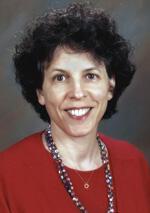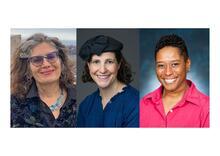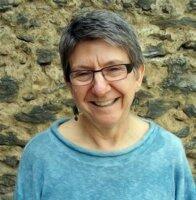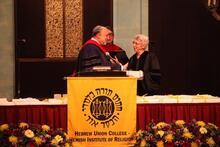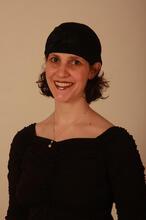Sally Jane Priesand
What is history to one generation is commonplace to another. Here is Sally Priesand (center) on her visit to Hebrew Union College - Jewish Institute of Religion on the twenty-fifth anniversary of her graduation. Everyone else in the picture is a rabbinical student, except for Karla Goldman, second from right, a faculty member.
Institution: Karla Goldman
Sally Priesand, the first woman in the world ordained by a rabbinical seminary, was not the first woman to dream of becoming a rabbi. Her dream was born before a new wave of feminism surged in the mid-1960s but became realized thanks to feminism’s success. Early in her career Rabbi Priesand saw stumbling blocks thrown in her way to thwart the woman who dared to crash a bastion of male privilege. Eventually, Rabbi Sally, as she was often known, found a pulpit and a home at Monmouth (NJ) Reform Temple. She led that congregation for a quarter of a century until her retirement from the active pulpit.
Becoming a Rabbi
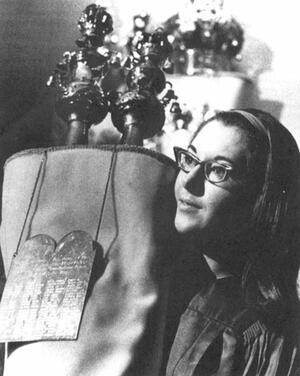
This photograph was taken in 1972, when Sally Jane Priesand became the first woman in the United States to be ordained as a rabbi. She faced many challenges on the road to acceptance. But she continued to struggle to carve a place for herself—and for all women—within the panoramic diversity of Judaism.
Institution: The Jacob Rader Marcus Center of the American Jewish Archives, Cincinnati, OH, www.americanjewisharchives.org and Garrett Cope, Citizen Patriot, Jackson, MI
Sally Priesand, who would later become the first female ordained rabbi in America, was born on June 27, 1946, in Cleveland Ohio, the daughter of Irving Theodore and Rose Elizabeth (Welch) Priesand. As a teenager at Beth Israel-West Temple, a Reform congregation on Cleveland’s West Side, she began to display an intense commitment to Judaism and Jewish life. Deeply spiritual and affected by the vision of Reform Judaism epitomized in its camps and youth groups in the early 1960s, she set her sights on becoming a rabbi long before an emerging women’s liberation movement raised anew the call for women’s access to traditionally male professions. [See Rabbis in the United States.]
In 1964, Priesand entered the University of Cincinnati. She knew that its joint undergraduate program with neighboring Hebrew Union College–Jewish Institute of Religion (HUC–JIR) would allow her to complete the first year of rabbinical school as an undergraduate. Accordingly, upon graduating from the University of Cincinnati in 1968, she was admitted to HUC–JIR’s rabbinical class of 1972.
As a rabbinical student, Priesand began to enjoy the rewards and experience the frustrations that would mark her career as the first female rabbi. Media attention swelled to a crescendo as she approached ordination, with headlines like “Girl Sets Her Goal to be First Woman Rabbi.” Priesand found herself standing before a wide spectrum of American Jews as a symbol of the emerging feminism they were just then confronting. Her rabbinical thesis, published as Judaism and the New Woman (1975), highlighted the changing role of women in Jewish history and was meant to advance their emancipation in Jewish religious life.
As Priesand sought student pulpits and performed fieldwork in congregations unable to hire full-time rabbis, she discovered that synagogues refused to interview her—or interviewed her only for the novelty—claiming they could not possibly hire a woman rabbi. Experiences in student pulpits in Milwaukee, Wisconsin; Champaign, Illinois; Hattiesburg, Mississippi; and at Cincinnati’s Isaac Mayer Wise Temple conveyed what Priesand would soon describe as “the unbelievable and almost unbearable pressures of being the first woman rabbi.”
On June 3, 1972, when Alfred Gottschalk, president of HUC–JIR, ordained her, Priesand became the first woman in the world ordained by a rabbinical seminary.
The First Woman Rabbi
Priesand found her first job at New York City’s Stephen Wise Free Synagogue as assistant and then associate rabbi (1972–1979). In 1979, she left the congregation when she was not promised that she would succeed its ailing senior rabbi.
In the next years, Priesand again found temple boards using her gender as an excuse not to hire her. Unable to secure a new position commensurate with her experience in the rabbinate, she took a part-time pulpit at Temple Beth El in Elizabeth, New Jersey (1979–1981), worked as a chaplain at Manhattan’s Lenox Hill Hospital, and briefly contemplated leaving the rabbinate.
In 1981, when she became rabbi at Monmouth Reform Temple, in Tinton Falls, New Jersey, Priesand found the pulpit and community that she had long sought. This mid-sized congregation of some 285 families responded warmly to her leadership. She infused their worship services with more Hebrew and congregational singing and shared her deep commitments to the needs of the poor, the survival of Israel, and the cause of justice and peace, propelling the congregation to social action. Together Priesand and her congregants forged a creative partnership guided by her conviction that a rabbi’s primary task is to help Jews take responsibility for their own Judaism.
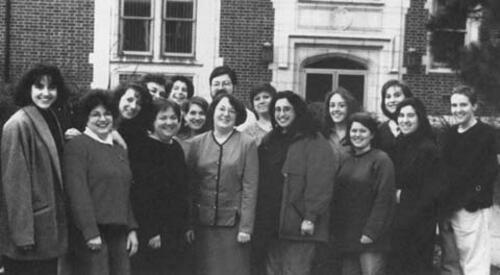
What is history to one generation is commonplace to another. Here is Sally Priesand (center) on her visit to Hebrew Union College - Jewish Institute of Religion on the twenty-fifth anniversary of her graduation. Everyone else in the picture is a rabbinical student, except for Karla Goldman, second from right, a faculty member.
Institution: Karla Goldman
Outside the congregation, Priesand worked with the Reform Movement’s Central Conference of American Rabbis’ Task Force on Women in the Rabbinate to try to smooth the way for the women who followed her. At the twentieth anniversary of her ordination, she again voiced her oft-repeated critique that the institutions of Reform Judaism had still not demonstrated equality of the sexes. In honor of her 25th anniversary in 1997, she received an honorary doctorate from the HUC-JIR, and her congregants contributed toward the establishment of the Rabbi Sally J. Priesand Visiting Professorship in Jewish Women’s Studies to bring a leading scholar for a week to one of HUC-JIR’s four campuses.
Priesand was an avid painter, exhibiting her watercolors at the HUC-JIR campus in New York in 2002. She continued her activity after her retirement in 2006, after a quarter of a century as rabbi at Monmouth Reform Temple. In 2010, she appeared on stage in Boston and later in Philadelphia with the other women “firsts”—Rabbi Sandy Sasso (Reconstructionist, 1974), Rabbi Amy Eilberg (Conservative, 1985), Rabbah Sara Hurwitz (Open Orthodox, 2009)— to recount stories of their roads to the rabbinate, the obstacles they had faced, and the successes they had achieved.
Selected Works
Judaism and the New Woman. Millburn, NJ: Behrman House, 1975.
“Postscript.” In Women Rabbis: Exploration and Celebration. Papers Delivered at an Academic Conference Honoring Twenty years of Women in the Rabbinate, 1972–1992, edited by Gary P. Zola. Hebrew Union College Press, 1996.
“Preparation for the Rabbinate—Yesterday, Tomorrow.” Central Conference of American Rabbis Yearbook 85 (1975): 162–164.
Hume, Jack. “Girl Sets Her Goal to Be First Woman Rabbi.” Cleveland Plain Dealer, March/April 1964.
Mirsky, Norman. Unorthodox Judaism. Columbus, OH: Ohio State University Press, 1978.
Nadell, Pamela S. Women Who Would Be Rabbis: A History of Women’s Ordination, 1889–1985. Boston: Beacon Press, 1998.
Proctor, Priscilla, and William Proctor. Women in the Pulpit: Is God an Equal Opportunity Employer? Garden City, NY: Doubleday, 1976.


